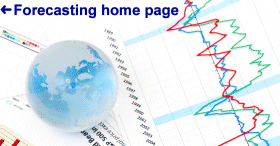
a. Overview of forecasting: how do you predict the future? What
kind of accuracy is possible?
b. Where to obtain data; data sources at Fuqua and on the web
c. How to move data around: useful things you can do with your
word processor and spreadsheet
d. What to look for in data: seasonality, inflation, trends, cycles,
etc.
e. How to transform data to reveal its structure; deflation, logging,
seasonal adjustment
f. Illustration of basic operations in Statgraphics
Reading assignment: Statgraphics Tutorial Introduction, H&R Chapters 1 and 3 (note: ignore details of how to use Minitab, SAS, and Forecast Plus throughout the book); also glance at pages 320-322 (how to use price indices) and pages 338-342 (how to compute seasonal indices), we'll return to these in lecture 3
Additional lecture notes:
Famous forecasting quotes
How to shovel data around
Get to know your data
Inflation adjustment (deflation)
Seasonal adjustment
Stationarity and differencing
The logarithm transformation
a. Forecasting a stationary series: the "mean" model
b. Forecasting a nonstationary series I: the trend line model
c. Forecasting a nonstationary series II: the random walk ("naive")
model
d. How to identify a random walk: differencing and autocorrelation
analysis
e. Geometric random walk: the basic stock price model
f. Three types of forecasts: estimation period, validation period,
and long-term extrapolation
g. How to evaluate forecast errors and compare models
Reading: Skim Chapter 2 and read Chapter 4, plus the first few
pages of Chapter 5 (naive models) in H&R
Additional lecture notes:
Mean
Linear trend
Random walk
Random walk with growth
Geometric random walk
Three types of forecasts: estimation period, validation period, and the future
HOMEWORK ASSIGNMENT #1
HW#1 due
a. General considerations in working with seasonal data: causes
of seasonality, stability of seasonal patterns
b. Seasonal random walk; and seasonal random trend models
c. Seasonal adjustment by the ratio-to-moving-average method
d. Additive versus multiplicative seasonal adjustment
e. Adjustments for holidays and trading days
f. Trend/cycle decomposition of time series
Reading: Chapter 8 (decomposition of time series, calculation of seasonal indices)
Addtional notes:
Seasonal differencing
Seasonal random walk
Seasonal random trend
Lecture 3 slides: working with seasonal data (revised Sep. 11)
Data set for assignment #2
a. Simple moving average model
b. Exponential smoothing model
c. Combination of smoothing and seasonal adjustment
d. Robust models for noisy data
e. Massively parallel forecasting
Reading: Remainder of Chapter 5 (moving averages and smoothing methods)
Additional notes:
Averaging and exponential smoothing models
Spreadsheet implementation of seasonal adjustment and exponential smoothing (revised 9/17)
HW#2 due
a. Indiana Jones and the temple of R-squared
b. Correlation matrices, autocorrelation and cross-correlation
functions
c. Fitting simple regression models; interpreting output
Reading: Chapter 6
Additional notes:
Introduction to regression analysis
Example of regression analysis: predicting auto sales from personal income
DATA SET FOR ASSIGNMENT #3 (FIXED 9/21)
NEW GRAPHICS DEFAULTS FOR STATGRAPHICS
a. Fitting time series regression models
Reading: Chapter 7
Additional notes:
Fitting time series regression models
What to look for in regression output
HW#3 due
a. What's a good value for R-squared?
b. Not-so-simple regression models
Reading: Chapter 9
Additional notes:
What's a good value for R-squared?
Not-so-simple regression models
DATA SET FOR ASSIGNMENT #4
a. The four horsemen of linear regression
b. What's the bottom line?
c. Stepwise and all-subsets regression
d. Business cycle indicators
Additional notes:
Testing the assumptions of linear regression
What's the bottom line? How to compare models
Stepwise and all-possible-regressions
Business Cycle Indicators
a. Naive + Autoregressive + Exponential Smoothing = ARIMA
b. Using ACF and PACF plots to determine the "signature"
of a time series
c. Fitting non-seasonal ARIMA models
d. The spectrum of ARIMA models
Reading: Chapter 10
Additional notes (revised 9/30):
Introduction to ARIMA: nonseasonal models
Identifying the order of differencing
Identifying the orders of AR or MA terms
Rules for identifying ARIMA models
HW#4 due
a. Identification of seasonal models
b. Examples of seasonal model-fitting
c. Spreadsheet implementation
Additional notes:
Estimation of ARIMA models
Seasonal ARIMA models
Designated project" option (there is no HW#5)
a. Combination of ARIMA and regression models
b. Recap of steps in choosing a forecasting model
c. Automatic forecasting software
Additional notes:
ARIMA models with regressors
Steps in choosing a forecasting model
Forecasting flow chart
Automatic forecasting software
a. Political and ethical issues in forecasting
b. Review of models: what to use and when
Reading: Chapter 11
Political and ethical issues in forecasting
How to avoid trouble
Data transformations and forecasting models: what to use and when
GUIDELINES FOR FINAL PROJECTS
Notes concerning the final project (transforming, untransforming, comparing models, etc.)
Last updated October 11, 1996. Always under construction.